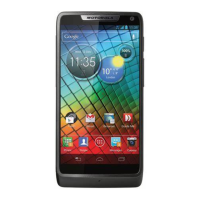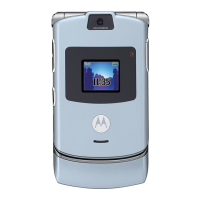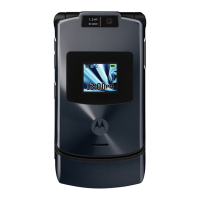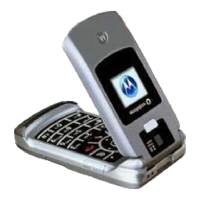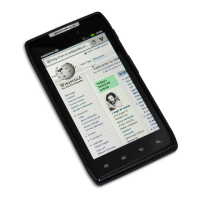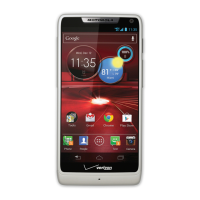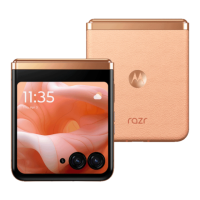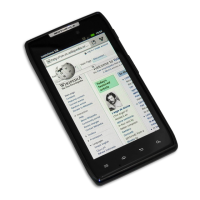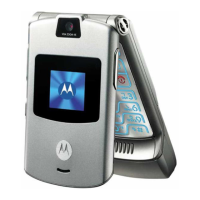57
RF energy operational precautions
For optimal mobile device performance, and to be sure that human exposure to RF energy
does not exceed the guidelines set forth in the relevant standards, always follow these
instructions and precautions:
•
When placing or receiving a phone call, hold your mobile device just like you would a
landline phone.
•
If you wear the mobile device on your body, always place the mobile device in a
Motorola-supplied or approved clip, holder, holster, case or body harness. If you do not
use a body-worn accessory supplied or approved by Motorola, keep the mobile device and
its aerial at least 2.5 cm (1 inch) from your body when transmitting.
•
Using accessories not supplied or approved by Motorola may cause your mobile device to
exceed RF energy exposure guidelines. For a list of Motorola-supplied or approved
accessories, visit our website at:
www.motorola.com
.
RF energy interference/compatibility
Nearly every electronic device is subject to RF energy interference from external sources if
inadequately shielded, designed or otherwise configured for RF energy compatibility. In some
circumstances, your mobile device may cause interference with other devices.
Follow instructions to avoid interference problems
Turn off your mobile device in any location where posted notices instruct you to do so, such
as hospitals or healthcare facilities.
In an aircraft, turn off your mobile device whenever instructed to do so by airline staff. If your
mobile device offers flight mode or a similar feature, consult airline staff about using it
in-flight.
Medical devices
If you have a medical device, including an implantable medical device such as a pacemaker
or defibrillator, consult your healthcare provider and the device manufacturer's directions
before using this mobile device.
Persons with implantable medical devices should observe the following precautions:
•
ALWAYS keep the mobile device more than 20 centimetres (8 inches) from the
implantable medical device when the mobile device is turned ON.
•
DO NOT carry the mobile device in the breast pocket.
•
Use the ear opposite the implantable medical device to minimise the potential for
interference.
•
Turn OFF the mobile device immediately if you have any reason to suspect that
interference is taking place.
Read and follow the directions from the manufacturer of your implantable medical device. If
you have any questions about using your mobile device with your implantable medical
device, consult your healthcare provider.
Regulatory information
Your Motorola mobile device is designed to comply with national and international regulatory
requirements. For full compliance statements and details, please refer to the regulatory
information in your printed product guide.
Location services (GPS & AGPS)
GPS & AGPS
The following information is applicable to Motorola mobile devices that provide location
based (GPS and/or AGPS) functionality.
Your mobile device can use Global Positioning System (GPS) signals for location-based
applications. GPS uses satellites controlled by the U.S. government that are subject to
changes implemented in accordance with the Department of Defense policy and the Federal
Radionavigation Plan. These changes may affect the performance of location technology on
your mobile device.
Your mobile device can also use Assisted Global Positioning System (AGPS), which obtains
information from the mobile network to improve GPS performance. AGPS uses your wireless
service provider's network and therefore airtime, data charges and/or additional charges may
apply in accordance with your service plan. Contact your wireless service provider for details.
Your location
Location-based information includes information that can be used to determine the approximate
location of a mobile device. Mobile devices that are connected to a wireless network transmit
location-based information. Devices enabled with GPS or AGPS technology also transmit
location-based information. Additionally, if you use applications that require location-based
information (e.g. driving directions), such applications transmit location-based information. This
location-based information may be shared with third parties, including your wireless service
provider, applications providers, Motorola and other third parties providing services.
Emergency calls
When you make an emergency call, the mobile network may activate the AGPS technology in
your mobile device to tell the emergency responders your approximate location.
AGPS has limitations and
might not work in your area
. Therefore:
•
Always tell the emergency responder your location to the best of your ability; and
•
Remain on the phone for as long as the emergency responder instructs you.
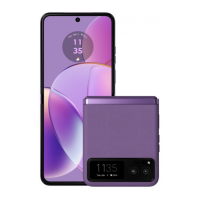
